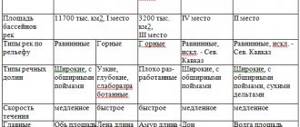so UNT / Geography / Lesson plans for geography 9th grade
Lesson 36 Geography of mechanical engineering
20.08.2014 18233 0
Objectives: To introduce the geography and factors of location of the engineering industry. Define the concepts of “specialization” and “cooperation”.
Equipment: Card "Mechanical Engineering".
During the classes
I.
Organizing time
II.
Checking homework
Orally:
1) Talk about the importance and composition of the mechanical engineering complex.
2) Name the problems of the mechanical engineering complex and ways to solve them.
Written question on the board:
3) Draw up a diagram of intersectoral connections of the mechanical engineering complex.
III.
Learning new material
— What factors should be taken into account when locating machine-building plants? Where should a machine-building plant be built so that it works rhythmically, the products are competitive, and the enterprise is not unprofitable?
When placing mechanical engineering, several factors are taken into account:
1.
Science intensity
- The newest industries (electronics, aerospace, nuclear industry) are based on a scientific base - research institutes, design bureaus, pilot plants, since they are knowledge-intensive.
Question: Define the geography of high-tech industries.
Answer: The geography of knowledge-intensive industries coincides with the largest cities (Moscow, St. Petersburg, Yekaterinburg) and science cities in the Moscow region: Zelenograd, Zhukovsky, Obninsk, Korolev.
2.
Labor intensity
— Mechanical engineering is divided into labor-intensive and metallurgical labor-intensive (precision), which produces products the manufacture of which requires the expenditure of skilled labor (instrument making, electrical engineering, mechanical engineering, aircraft manufacturing, etc.).
Question: Determine the geography of labor-intensive industries.
Answer: Labor-intensive industries are located in large cities where there are educational institutions that train qualified personnel. The centers of labor-intensive mechanical engineering are Moscow, Kazan, Samara and other large cities in the European part of Russia, which has a high concentration of population.
Metal-intensive (heavy) mechanical engineering (metallurgical, energy, mining) requires a lot of metal. Therefore, enterprises are located in areas of metallurgical bases - in the Urals (Ekaterinburg, Chelyabinsk).
Working with the map: Using the atlas map, find 5 heavy engineering centers.
Practical work
Determination of the main areas for the location of labor-intensive and metal-intensive mechanical engineering industries.
a) According to the “Mechanical Engineering” map of the atlas, or account. D., fig. 36, p. 101, identify the main areas of metal-intensive and labor-intensive mechanical engineering.
b) Name the centers of these branches of mechanical engineering.
c) Compare the “Mechanical Engineering” map with the atlas maps “Population Density” and “Metallurgy”. Draw conclusions about the relationship between centers of labor-intensive and metal-intensive mechanical engineering.
1. Specialization and cooperation
— One of the forms of production organization is specialization and cooperation.
Writing in a notebook
Specialization is the production of homogeneous products by an enterprise. This is a necessary condition for increasing the efficiency of industry.
The reverse side of this process is cooperation, since specialization implies close ties between related enterprises - cooperative ties.
Writing in a notebook
Cooperation is production relations between specialized enterprises that jointly produce certain products.
2. Transport factor
— Some mechanical engineering enterprises are located near the consumer, since their products are difficult to transport, so the transport factor is of great importance. For example, marine shipbuilding is located in ports, and combine harvesters in the steppe wheat region are located in Rostov-on-Don.
I. Consolidation
— Which branches of mechanical engineering (study D., table 2, appendix) produce labor-intensive products? (Instrument making, electrical engineering, aircraft manufacturing, machine tool manufacturing.)
— Name the products of precision (labor-intensive) engineering. (Watches, TVs, airplanes, machines.)
— What industries belong to metal-intensive engineering? (Mining equipment, metallurgical, energy.)
— What factors influence the location of labor-intensive and metal-intensive enterprises?
th mechanical engineering? (The presence of a high concentration of population and qualified personnel is a condition for the location of labor-intensive mechanical engineering. The presence of metal is a condition for the location of metal-intensive mechanical engineering.)
Homework
According to school D.: §18-19; According to school A.: §31.
Sociocultural workshop assignment No. 1-2 (optional).
Self-assessment questions No. 5,6.
Lesson summary "Mechanical engineering of the Russian Federation, placement factors" in geography for grade 9
Methodological development of a geography lesson in grade 9 on the topic “Mechanical engineering of the Russian Federation, placement factors.”
Methodological material on geography (grade 9).
Author
: Elena Vladimirovna Zamolotskikh, geography teacher, MBOU secondary school. Storozhevoye, Usma district, Lipetsk region
Basic tutorial:
Dronov V.P. Geography of Russia. Population. Farming. 9th grade / V. P. -Dronov, V. Ya. Rom,. - M.: Bustard, 2009.
Target:
form an idea of the significance, composition, connections of the mechanical engineering complex, location factors, mechanical engineering centers;
Tasks:
1) Development of cognitive skills (highlight the main thing, draw up a diagram, establish cause-and-effect relationships); 2) Development of skills in partial search, cognitive and research activities (partial formulation of a problem, putting forward a hypothesis and its solution, independent vision of the problem); 3) Develop the ability and skills to work with maps; their analysis and comparison, the ability to make generalizations and conclusions;
Basic ZUN:
Mechanical engineering, its importance and industry composition. Connection with other industries.
During the classes.
1. Organizational moment.
2.Learning new material.
U.
Over the past 10 years, mechanical engineering output has decreased by 6%. Mechanical engineering is the leader of the country's economy. Why? Why does a Japanese plow last 40 years, and a domestic one 4 years? Do mechanical engineering workers need higher education?
So, today we will try to answer these questions and determine what the problems of the domestic mechanical engineering are.
Leading dialogue.
Teacher (U).
What are mechanical engineering products? Give examples of mechanical engineering products that you encounter in life.
Student (Teacher)
. Different cars. The examples are usually simple.
U
. In fact, MK produces a huge number of products and includes more than 200 industries. We can break them down into three large groups.
Working with Fig. 28 on page 64
Putting together a mechanical engineering composition diagram.
Placement factors
:
1. Metal intensity 4. Consumer orientation
2. Science intensity 5. Transport
3. Labor intensity 6. Military-strategic
Challenge students' opinions with a question or practical task
U
Let's look at the mechanical engineering map in the atlas. There are many punches, what they mean, how they are placed (Working with the map legend).
Uch.
There are a lot of punches, they are not evenly placed, it’s not clear.
U
. What question arises?
Uch
. Factors for the location of mechanical engineering (they know the plan for the characteristics of the complex)
U. So what is the main task of the lesson?
Uch.
Factors in the location of mechanical engineering.
The topic of the lesson is written on the board.
U.
Let's look at the example of mechanical engineering in the Lipetsk region.
What kind of mechanical engineering products do enterprises in the Lipetsk region produce?
Uch.
1. tractors, machine tools, electrical equipment
Encouraging dialogue
U
.Let's look at the diagram to which groups of industries our enterprises belong to.
Answer.
Exact, general, average, transport.
U.
What does the Lipetsk Tractor Plant produce? What is needed to produce products?….During the conversation we find out - qualified labor resources and knowledge intensity.
What explains the specialization of machine-building enterprises in the Lipetsk region?
Conclusion: focus on qualified resources and knowledge intensity.
(When working with high school students, it is desirable to put forward hypotheses, but testing hypotheses by the teacher and presenting an argument is acceptable.)
We work according to the diagram and map, find out the placement factors, and fill out the diagram.
U
. Features of mechanical engineering – specialization and cooperation. We give a definition (working with a textbook).
Application of knowledge by students.
Business game
. Guys, imagine that you are entrepreneurs. Having selected cities from the atlas map, determine what kind of mechanical engineering is developed there, and why? What other enterprise would you locate in this city? Justify your answer.
Summing up the work:
- Read the purpose of the lesson. Have you achieved your learning goal? In what degree?
- Evaluate your work.
- Homework: read §14, 15, 16 and propose your options for creating new machine-building enterprises in the Lipetsk region. Options - justify.
- Determine the range of problems associated with the geography of the mechanical engineering complex.




